check engine KIA STONIC 2018 Repair Manual
[x] Cancel search | Manufacturer: KIA, Model Year: 2018, Model line: STONIC, Model: KIA STONIC 2018Pages: 523, PDF Size: 24.99 MB
Page 440 of 523
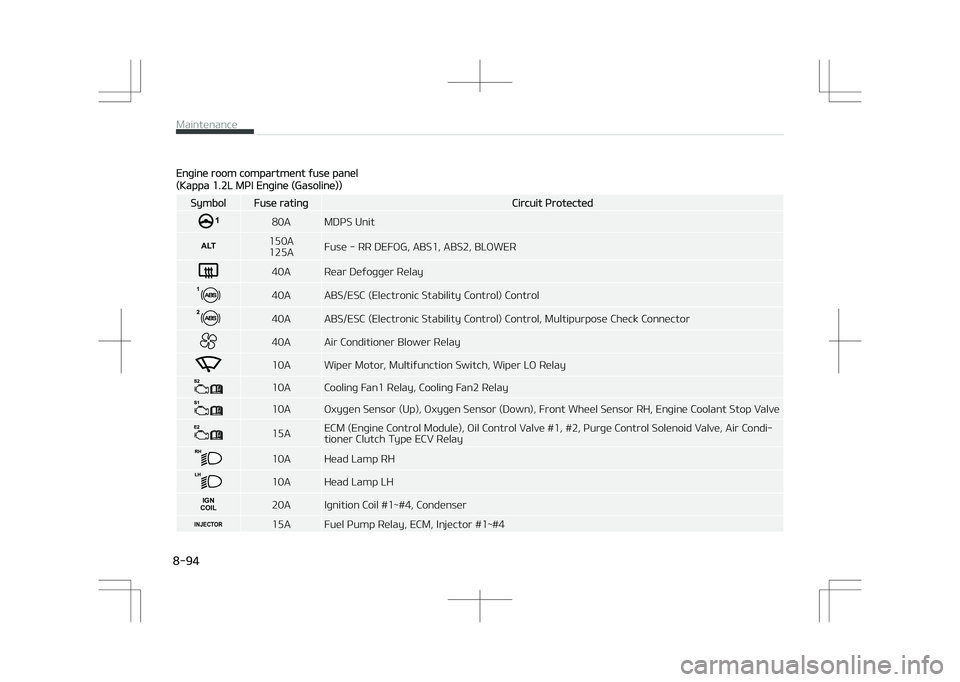
Engine room compartment fuse panel
(Kappa 1.2L MPI Engine (Gasoline))
SymbolFuse ratingCircuit Protected
80A MDPS Unit
ALT150A 125AFuse - RR DEFOG, ABS1, ABS2, BLOWER
40A Rear Defogger Relay
140A ABS/ESC (Electronic Stability Control) Control
40A ABS/ESC (Electronic Stability Control) Control, Multipurpose Check Connector
40A Air Conditioner Blower Relay
10A Wiper Motor, Multifunction Switch, Wiper LO Relay
10A Cooling Fan1 Relay, Cooling Fan2 Relay
10A Oxygen Sensor (Up), Oxygen Sensor (Down), Front Wheel Sensor RH, Engine Coolant Stop Valve
15AECM (Engine Control Module), Oil Control Valve #1, #2, Purge Control Solenoid Valve, Air Condi‐
tioner Clutch Type ECV Relay
10A Head Lamp RH
10A Head Lamp LH
IGN
COIL20A Ignition Coil #1~#4, Condenser
INJECTOR15A Fuel Pump Relay, ECM, Injector #1~#4
Maintenance
8-94
Page 443 of 523
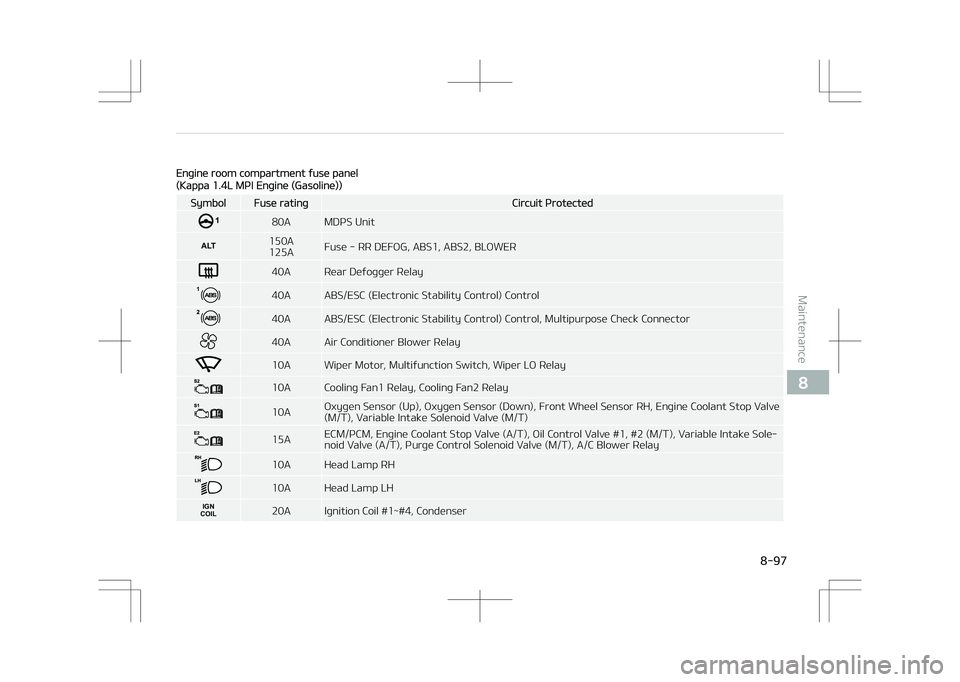
Engine room compartment fuse panel
(Kappa 1.4L MPI Engine (Gasoline))
SymbolFuse ratingCircuit Protected
80A MDPS Unit
ALT150A 125AFuse - RR DEFOG, ABS1, ABS2, BLOWER
40A Rear Defogger Relay
140A ABS/ESC (Electronic Stability Control) Control
40A ABS/ESC (Electronic Stability Control) Control, Multipurpose Check Connector
40A Air Conditioner Blower Relay
10A Wiper Motor, Multifunction Switch, Wiper LO Relay
10A Cooling Fan1 Relay, Cooling Fan2 Relay
10AOxygen Sensor (Up), Oxygen Sensor (Down), Front Wheel Sensor RH, Engine Coolant Stop Valve
(M/T), Variable Intake Solenoid Valve (M/T)
15AECM/PCM, Engine Coolant Stop Valve (A/T), Oil Control Valve #1, #2 (M/T), Variable Intake Sole‐
noid Valve (A/T), Purge Control Solenoid Valve (M/T), A/C Blower Relay
10A Head Lamp RH
10A Head Lamp LH
IGN
COIL20A Ignition Coil #1~#4, Condenser
8-97
8
Maintenance
Page 446 of 523
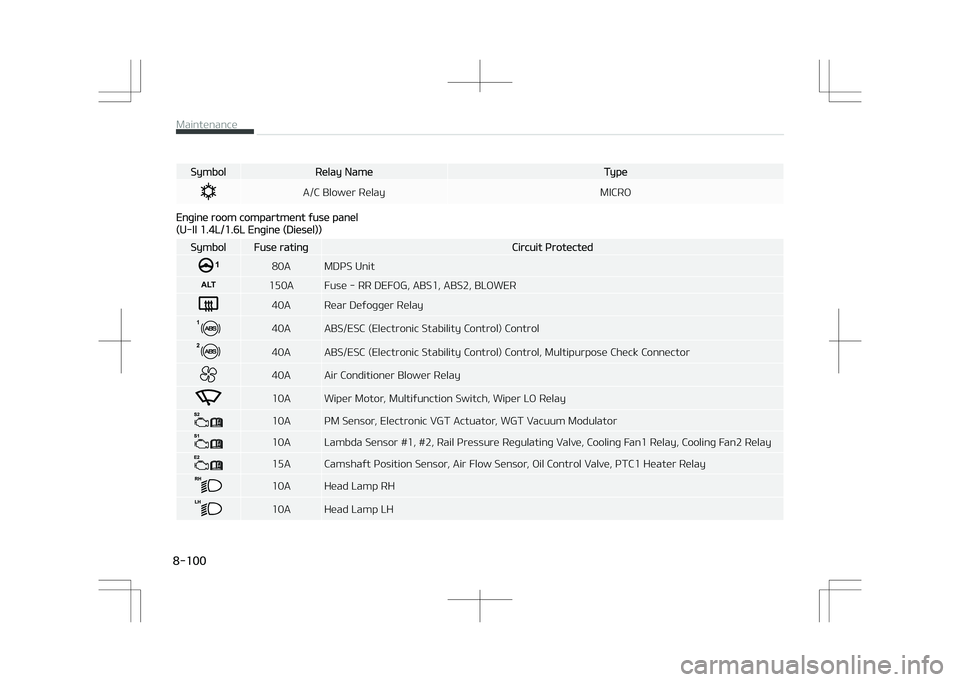
SymbolRelay NameType
A/C Blower RelayMICRO
Engine room compartment fuse panel
(U-II 1.4L/1.6L Engine (Diesel))
SymbolFuse ratingCircuit Protected
80A MDPS Unit
ALT150A Fuse - RR DEFOG, ABS1, ABS2, BLOWER
40A Rear Defogger Relay
140A ABS/ESC (Electronic Stability Control) Control
40A ABS/ESC (Electronic Stability Control) Control, Multipurpose Check Connector
40A Air Conditioner Blower Relay
10A Wiper Motor, Multifunction Switch, Wiper LO Relay
10A PM Sensor, Electronic VGT Actuator, WGT Vacuum Modulator
10A Lambda Sensor #1, #2, Rail Pressure Regulating Valve, Cooling Fan1 Relay, Cooling Fan2 Relay
15A Camshaft Position Sensor, Air Flow Sensor, Oil Control Valve, PTC1 Heater Relay
10A Head Lamp RH
10A Head Lamp LH
Maintenance
8-100
Page 481 of 523
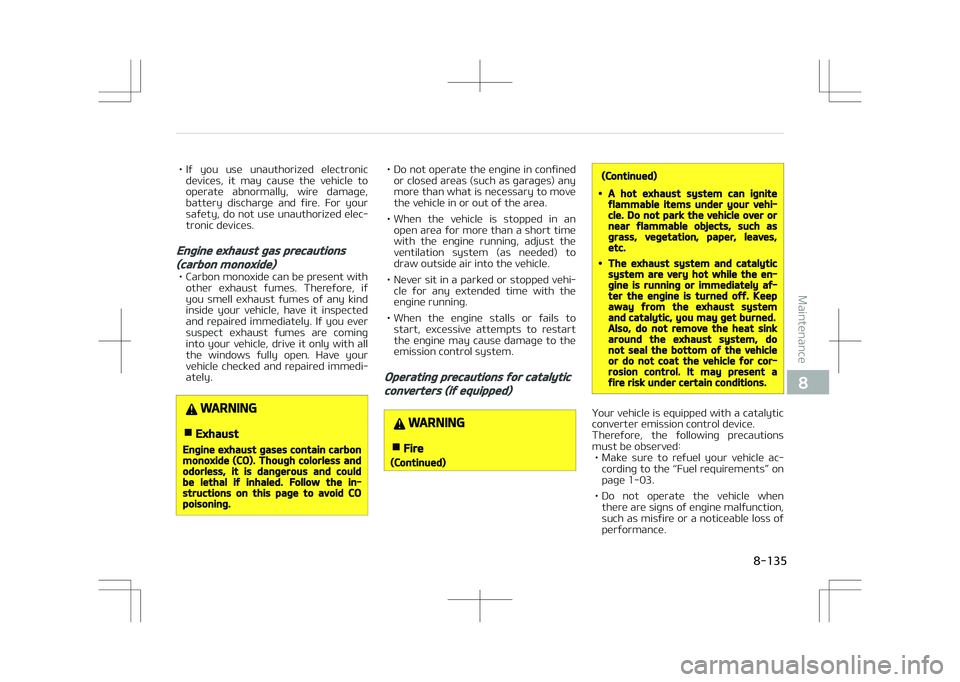
• If you use unauthorized electronicdevices, it may cause the vehicle to
operate abnormally, wire damage, battery discharge and fire. For your
safety, do not use unauthorized elec‐
tronic devices.
Engine exhaust gas precautions
(carbon monoxide)
• Carbon monoxide can be present with other exhaust fumes. Therefore, if
you smell exhaust fumes of any kind inside your vehicle, have it inspected
and repaired immediately. If you ever
suspect exhaust fumes are coming
into your vehicle, drive it only with all
the windows fully open. Have your vehicle checked and repaired immedi‐
ately.
WARNING
nExhaust
Engine exhaust gases contain carbonmonoxide (CO). Though colorless andodorless, it is dangerous and couldbe lethal if inhaled. Follow the in‐structions on this page to avoid COpoisoning.
• Do not operate the engine in confined or closed areas (such as garages) any
more than what is necessary to move the vehicle in or out of the area.
• When the vehicle is stopped in an open area for more than a short time
with the engine running, adjust the
ventilation system (as needed) to
draw outside air into the vehicle.
• Never sit in a parked or stopped vehi‐ cle for any extended time with the
engine running.
• When the engine stalls or fails to start, excessive attempts to restart
the engine may cause damage to the
emission control system.
Operating precautions for catalytic
converters (if equipped)
WARNING
nFire
(Continued)
(Continued)
•A hot exhaust system can igniteflammable items under your vehi‐cle. Do not park the vehicle over ornear flammable objects, such asgrass, vegetation, paper, leaves,etc.
•The exhaust system and catalyticsystem are very hot while the en‐gine is running or immediately af‐ter the engine is turned off. Keepaway from the exhaust systemand catalytic, you may get burned.Also, do not remove the heat sinkaround the exhaust system, donot seal the bottom of the vehicleor do not coat the vehicle for cor‐rosion control. It may present afire risk under certain conditions.
Your vehicle is equipped with a catalytic
converter emission control device.
Therefore, the following precautions must be observed: • Make sure to refuel your vehicle ac‐ cording to the L
Page 482 of 523
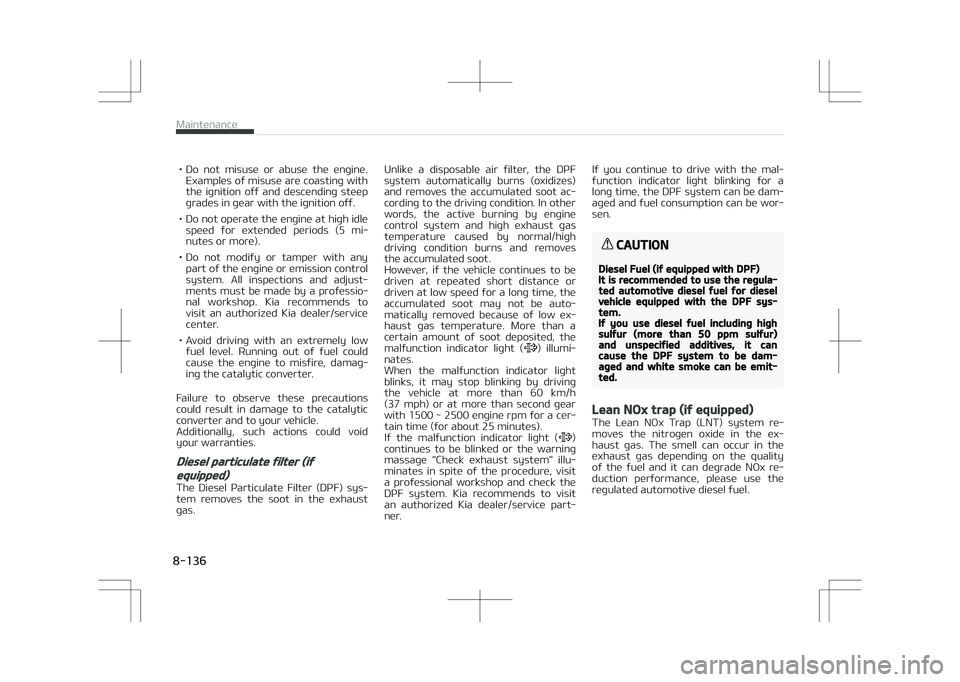
• Do not misuse or abuse the engine.Examples of misuse are coasting with
the ignition off and descending steep grades in gear with the ignition off.
• Do not operate the engine at high idle speed for extended periods (5 mi‐
nutes or more).
• Do not modify or tamper with any part of the engine or emission control
system. All inspections and adjust‐ ments must be made by a professio‐
nal workshop. Kia recommends to
visit an authorized Kia dealer/service
center.
• Avoid driving with an extremely low fuel level. Running out of fuel couldcause the engine to misfire, damag‐
ing the catalytic converter.
Failure to observe these precautions
could result in damage to the catalytic converter and to your vehicle.
Additionally, such actions could void
your warranties.
Diesel particulate filter (if
equipped)
The Diesel Particulate Filter (DPF) sys‐
tem removes the soot in the exhaust gas. Unlike a disposable air filter, the DPF
system automatically burns (oxidizes)
and removes the accumulated soot ac‐ cording to the driving condition. In other
words, the active burning by engine
control system and high exhaust gas temperature caused by normal/high
driving condition burns and removes
the accumulated soot.
However, if the vehicle continues to be driven at repeated short distance or
driven at low speed for a long time, the
accumulated soot may not be auto‐ matically removed because of low ex‐
haust gas temperature. More than a
certain amount of soot deposited, the malfunction indicator light (
) illumi‐
nates.
When the malfunction indicator light
blinks, it may stop blinking by driving
the vehicle at more than 60 km/h (37 mph) or at more than second gear
with 1500 ~ 2500 engine rpm for a cer‐
tain time (for about 25 minutes).
If the malfunction indicator light (
)
continues to be blinked or the warning
massage "Check exhaust system" illu‐ minates in spite of the procedure, visit
a professional workshop and check the
DPF system. Kia recommends to visit an authorized Kia dealer/service part‐
ner. If you continue to drive with the mal‐
function indicator light blinking for a long time, the DPF system can be dam‐
aged and fuel consumption can be wor‐
sen.
CAUTION
Diesel Fuel (if equipped with DPF)It is recommended to use the regula‐ted automotive diesel fuel for dieselvehicle equipped with the DPF sys‐tem.If you use diesel fuel including highsulfur (more than 50 ppm sulfur)and unspecified additives, it cancause the DPF system to be dam‐aged and white smoke can be emit‐ted.
Lean NOx trap (if equipped)
The Lean NOx Trap (LNT) system re‐
moves the nitrogen oxide in the ex‐ haust gas. The smell can occur in the
exhaust gas depending on the quality
of the fuel and it can degrade NOx re‐ duction performance, please use the
regulated automotive diesel fuel.
Maintenance
8-136
Page 497 of 523
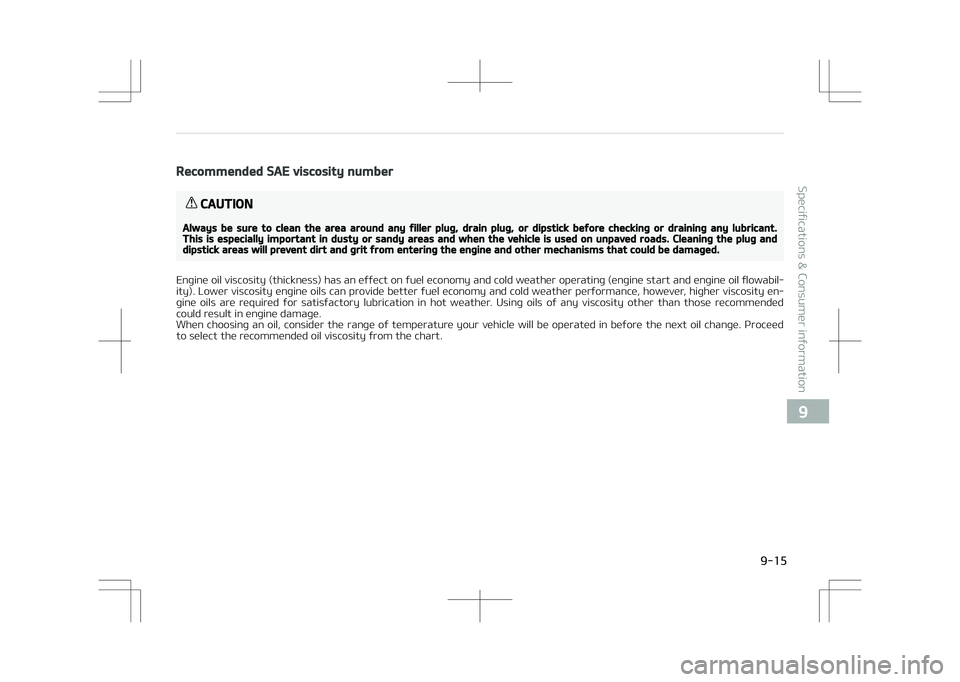
Recommended SAE viscosity number
CAUTION
Always be sure to clean the area around any filler plug, drain plug, or dipstick before checking or draining any lubricant.This is especially important in dusty or sandy areas and when the vehicle is used on unpaved roads. Cleaning the plug anddipstick areas will prevent dirt and grit from entering the engine and other mechanisms that could be damaged.
Engine oil viscosity (thickness) has an effect on fuel economy and cold weather operating (engine start and engine oil flowabil‐
ity). Lower viscosity engine oils can provide better fuel economy and cold weather performance, however, higher viscosity en‐ gine oils are required for satisfactory lubrication in hot weather. Using oils of any viscosity other than those recommended
could result in engine damage.
When choosing an oil, consider the range of temperature your vehicle will be operated in before the next oil change. Proceed to select the recommended oil viscosity from the chart.
9-15
9
Specifications & Consumer information